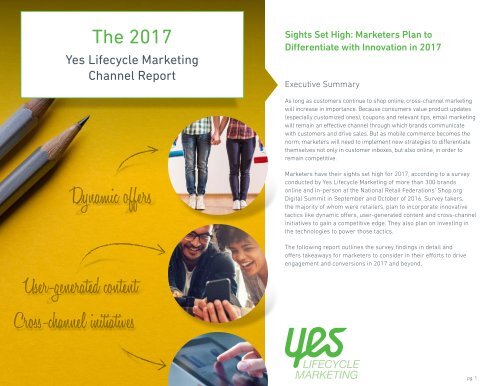2017 Channel Report - Sights Set High - Marketers Plan to Differentiate with Innovation
Create successful ePaper yourself
Turn your PDF publications into a flip-book with our unique Google optimized e-Paper software.
The <strong>2017</strong><br />
Yes Lifecycle Marketing<br />
<strong>Channel</strong> <strong>Report</strong><br />
<strong>Sights</strong> <strong>Set</strong> <strong>High</strong>: <strong>Marketers</strong> <strong>Plan</strong> <strong>to</strong><br />
<strong>Differentiate</strong> <strong>with</strong> <strong>Innovation</strong> in <strong>2017</strong><br />
Executive Summary<br />
As long as cus<strong>to</strong>mers continue <strong>to</strong> shop online, cross-channel marketing<br />
will increase in importance. Because consumers value product updates<br />
(especially cus<strong>to</strong>mized ones), coupons and relevant tips, email marketing<br />
will remain an effective channel through which brands communicate<br />
<strong>with</strong> cus<strong>to</strong>mers and drive sales. But as mobile commerce becomes the<br />
norm, marketers will need <strong>to</strong> implement new strategies <strong>to</strong> differentiate<br />
themselves not only in cus<strong>to</strong>mer inboxes, but also online, in order <strong>to</strong><br />
remain competitive.<br />
<strong>Marketers</strong> have their sights set high for <strong>2017</strong>, according <strong>to</strong> a survey<br />
conducted by Yes Lifecycle Marketing of more than 300 brands<br />
online and in-person at the National Retail Federations’ Shop.org<br />
Digital Summit in September and Oc<strong>to</strong>ber of 2016. Survey takers,<br />
the majority of whom were retailers, plan <strong>to</strong> incorporate innovative<br />
tactics like dynamic offers, user-generated content and cross-channel<br />
initiatives <strong>to</strong> gain a competitive edge. They also plan on investing in<br />
the technologies <strong>to</strong> power those tactics.<br />
The following report outlines the survey findings in detail and<br />
offers takeaways for marketers <strong>to</strong> consider in their efforts <strong>to</strong> drive<br />
engagement and conversions in <strong>2017</strong> and beyond.<br />
pg. 1
Please rank your <strong>to</strong>p three most important marketing goals for<br />
<strong>2017</strong> <strong>with</strong> #1 being the most important:<br />
Priority #1 Priority #2 Priority #3<br />
Increase sales<br />
34.7% | 13.7% | 6.3%<br />
Improve cus<strong>to</strong>mer<br />
engagement<br />
18.7% | 16.7% | 15.4%<br />
Improve cus<strong>to</strong>mer acquisition<br />
12.3% | 14.3% | 17.5%<br />
Improve cus<strong>to</strong>mer retention<br />
11.3% | 15.7% | 9.8%<br />
Build a better understanding<br />
of the cus<strong>to</strong>mer<br />
8.3% | 11.6% | 12.3%<br />
Improve profitability / margin<br />
7.3% | 6.8% | 8.8%<br />
10% 20% 30% 40% 50% 60%<br />
As <strong>with</strong> most marketers, “increase sales” should be, and is, the #1<br />
priority. Supporting this goal is always the challenge, and what keeps<br />
marketers up at night.<br />
Responses from those surveyed suggest that, at the very least,<br />
marketers know what they must do in order <strong>to</strong> get there, even though,<br />
in many cases, they acknowledge they are not there yet.<br />
For example, the majority of survey takers admitted that their<br />
personalization efforts are weak; but they do know what they need <strong>to</strong><br />
do <strong>to</strong> make this a priority in order <strong>to</strong> better serve their audiences in<br />
<strong>2017</strong>. While some brands do not yet use web browsing or purchase<br />
his<strong>to</strong>ry data <strong>to</strong> cus<strong>to</strong>mize offers, many are looking <strong>to</strong> incorporate more<br />
advanced tactics like cross-channel or dynamic offers <strong>to</strong> improve<br />
relevancy. Brands will look <strong>to</strong> marketing technology and service<br />
providers <strong>to</strong> help get them on the right path through an emphasis on<br />
technology innovation and analytic services.<br />
Improve cross-channel<br />
effectiveness<br />
3.7% | 12.6% | 11.2%<br />
Improve internal efficiency<br />
2.0% | 4.8% | 12.6%<br />
Reduce marketing costs<br />
1.0% | 3.8% | 6.0%<br />
None of these<br />
0.7% | 0.0% | 0.0%<br />
pg. 2
Key Findings<br />
• Brands will invest in cross-channel initiatives <strong>to</strong> improve upon<br />
existing tactics:<br />
Forty percent say they will implement cross-channel attribution<br />
initiatives in <strong>2017</strong>, and 38 percent plan <strong>to</strong> implement test <strong>to</strong>ols for<br />
channel and content.<br />
Your Offer Inside!<br />
• Brands will differentiate themselves <strong>with</strong> more sophisticated<br />
marketing techniques:<br />
Thirty-eight percent say that while they’re not using usergenerated<br />
content currently, they’d like <strong>to</strong> do so in the next year.<br />
• <strong>Marketers</strong> know their personalization efforts are weak and see<br />
value in improvement:<br />
Forty-nine percent say they feel their communication efforts are<br />
one-size-fits-all and 68 percent say they wish they could improve<br />
these efforts in <strong>2017</strong>.<br />
• Brands are turning <strong>to</strong> marketing service providers and<br />
technology for innovation:<br />
According <strong>to</strong> survey takers, technology innovation is the most<br />
important area when selecting a cross-channel marketing service<br />
provider, followed by analytic services.<br />
Your Offer Inside!<br />
• <strong>Marketers</strong> consider virtual reality a luxury, not a necessity: Fiftyseven<br />
percent believe that virtual reality does not apply <strong>to</strong> their<br />
organizations, and 55 percent say the same about augmented<br />
reality.<br />
• <strong>Marketers</strong> see value in marketing investments:<br />
Only one in ten cite reducing marketing costs as a priority<br />
for <strong>2017</strong>.<br />
pg. 3
Which of the following channels will receive an increase in<br />
attention/budget from you/your marketing team in <strong>2017</strong>?<br />
Email<br />
Social<br />
Display<br />
SMS<br />
Direct Mail<br />
Push<br />
Telemarketing<br />
Mobile Wallet<br />
Email<br />
18%<br />
17%<br />
15%<br />
8%<br />
7%<br />
37%<br />
54%<br />
What cross-channel initiatives are you looking <strong>to</strong><br />
implement in <strong>2017</strong>?<br />
68%<br />
Cross-channel attribution 40%<br />
Test <strong>to</strong>ols for channel and content<br />
Data-fed, consistent view of<br />
the cus<strong>to</strong>mer<br />
35%<br />
Integrated au<strong>to</strong>mated offer optimization 33%<br />
Contextual content management 30%<br />
Self-service audience segmenation 28%<br />
Alternative, targeted acquisition 26%<br />
Competitive interaction reporting 17%<br />
38%<br />
<strong>Marketers</strong> plan <strong>to</strong> integrate channels <strong>to</strong><br />
improve the cus<strong>to</strong>mer experience and drive<br />
sales in <strong>2017</strong><br />
<strong>Marketers</strong> want <strong>to</strong> improve cus<strong>to</strong>mer engagement and increase sales<br />
in <strong>2017</strong>. They will continue <strong>to</strong> utilize proven marketing channels such<br />
as email and social media <strong>to</strong> achieve this goal. However, many plan <strong>to</strong><br />
implement cross-channel initiatives <strong>to</strong> break down the siloes between<br />
these channels and offer cus<strong>to</strong>mers relevant, integrated experiences.<br />
On average, marketers will increase attention or budget of 1.7 channels.<br />
Most respondents (68 percent) report that email marketing will receive<br />
an increase in marketing budget this year. Social media marketing<br />
will also be a priority, <strong>with</strong> more than half (54 percent) reporting their<br />
organizations’ social media budget will increase. Offline initiatives such<br />
as telemarketing and direct mail rank low on the list.<br />
Brands also see value in integrating digital and offline <strong>to</strong> gain a<br />
consistent view of the cus<strong>to</strong>mer and offer an improved experience.<br />
Many will implement cross-channel marketing strategies in the year<br />
ahead <strong>to</strong> integrate siloed communication programs. Forty percent say<br />
they are looking <strong>to</strong> implement cross-channel attribution initiatives,<br />
followed by test <strong>to</strong>ols for channels and content at 38 percent and a<br />
data-fed, consistent view of the cus<strong>to</strong>mer at 35 percent.<br />
Takeaway:<br />
Email remains and will continue <strong>to</strong> be a tried and true method of<br />
cus<strong>to</strong>mer communication. With social and display rounding out the<br />
<strong>to</strong>p three channels <strong>to</strong> receive an increase in attention and/or budget<br />
from marketers, brands are understanding the need <strong>to</strong> present<br />
relevant cus<strong>to</strong>mer experiences across these channels in order <strong>to</strong><br />
increase engagement <strong>with</strong> their audience.<br />
Similarly, these <strong>to</strong>p three cross-channel initiatives, as noted in<br />
the graph <strong>to</strong> the left, support the path <strong>to</strong> improve the cus<strong>to</strong>mer<br />
experience, which will ultimately drive sales.<br />
Other 4%<br />
pg. 4
Advanced Tactics<br />
Social media share but<strong>to</strong>ns<br />
Retailers express interest in more advanced<br />
marketing tactics like dynamic offers and<br />
user-generated content<br />
Video<br />
68% 20% 4% 8%<br />
Most brands already incorporate tactics like social media share but<strong>to</strong>ns<br />
(68 percent) and video (56 percent), However, it may be surprising<br />
about one in five (19 percent) say they are not using social media share<br />
but<strong>to</strong>ns but are interested in doing so in <strong>2017</strong>, and 26 percent said the<br />
same about video.<br />
Dynamic offers<br />
User generated content<br />
Beacons<br />
56% 26% 6% 12%<br />
23% 46% 8% 23%<br />
38% 38% 8% 16%<br />
While most brands say they are not currently using advanced<br />
marketing tactics such as gamification and dynamic offers, many say<br />
they want <strong>to</strong> use them <strong>to</strong> innovate their marketing programs in <strong>2017</strong>.<br />
Almost half (46 percent) say that although they’re not using dynamic<br />
offers currently, they are interested in doing so this year. Thirty-eight<br />
percent say the same about user-generated content, and 29 percent<br />
say they are interested in beacons.<br />
Not surprisingly, virtual reality (a computer-generated environment)<br />
and augmented reality (superimposed images that alter a user’s<br />
current view of the world) continue <strong>to</strong> be considered nice-<strong>to</strong>-haves<br />
rather than necessities. However, almost three in five (57 percent)<br />
believe that virtual reality does not apply <strong>to</strong> their organization, and 55<br />
percent say the same about augmented reality.<br />
11% 28% 8% 53%<br />
Virtual reality<br />
8% 21% 14% 57%<br />
Augmented reality<br />
7% 25% 14% 54%<br />
Takeaway:<br />
The resistance <strong>to</strong>wards flashier tactics like VR and AR indicates<br />
that marketers are more pragmatic about their plans <strong>to</strong> improve<br />
marketing efforts. Alternately, they may want <strong>to</strong> ensure they achieve<br />
mastery first rather than competence alone <strong>with</strong> tactics that predate<br />
VR, AR and others. <strong>Marketers</strong> will instead focus on concrete, yet<br />
forward-thinking tactics that reach cus<strong>to</strong>mers at the right time and<br />
<strong>with</strong> the right message.<br />
Currently<br />
using<br />
Not using but<br />
interested in<br />
Have reservations about<br />
implementing<br />
Not<br />
applicable<br />
pg. 5
Which of the following data types do you use for<br />
communication personalization?<br />
Email engagement<br />
Recipient name<br />
Purchase his<strong>to</strong>ry<br />
Web behavior<br />
Demographic data<br />
Geographic data<br />
Social media engagement<br />
Display ads engagement<br />
I don’t use data 3%<br />
Other<br />
1%<br />
30%<br />
41%<br />
54%<br />
53%<br />
50%<br />
50%<br />
49%<br />
Which of the following content areas are you currently<br />
personalizing based on data insights?<br />
Subject line<br />
Recipient name<br />
Copy<br />
Frequency of campaigns<br />
Images<br />
Featured product<br />
Time of message delivery<br />
Offer<br />
We don’t personalize<br />
12%<br />
31%<br />
29%<br />
29%<br />
27%<br />
35%<br />
34%<br />
70%<br />
54%<br />
54%<br />
48%<br />
While they are optimistic for <strong>2017</strong>, many brands still fail <strong>to</strong> achieve<br />
basic levels of personalization, particularly <strong>with</strong> email. Many do not use<br />
common sources of consumer data, such as data enhancement, web<br />
behavior, or purchase his<strong>to</strong>ry, <strong>to</strong> personalize emails. Half of the survey<br />
respondents (50 percent) do not use web behavior data (such as the<br />
products a shopper has recently browsed) <strong>to</strong> personalize marketing<br />
content; 47 percent do not use purchase his<strong>to</strong>ry; and 45 percent do not<br />
personalize <strong>with</strong> the recipient’s name.<br />
Survey responses also exposed that many brands do not personalize<br />
basic email components like subject line or email body. When asked<br />
what content they personalize, responses show nearly half (46 percent)<br />
still do not personalize subject lines, and 65 percent still do not<br />
personalize email copy.<br />
Takeaway:<br />
There is definitely opportunity for improvement for marketers.<br />
With the right technology, marketers can personalize their<br />
communications. What’s more, cus<strong>to</strong>mers expect it. They want<br />
communications <strong>to</strong> be tailored <strong>to</strong> them based on what they need,<br />
when they need it. Effective personalization will increase response<br />
rates, build loyalty, and help drive market share.<br />
<strong>Marketers</strong> who have a 360-degree view of their cus<strong>to</strong>mers by<br />
accessing and analyzing their descriptive, response, and behavioral<br />
data will have a much better understanding of the needs of their<br />
cus<strong>to</strong>mers. The insights derived from this data can then influence<br />
content <strong>to</strong> better target their communications.<br />
pg. 6
In which channels do you wish you could<br />
improve personalization?<br />
59%<br />
68%<br />
Despite aspirations, many retailers know<br />
they still miss the mark <strong>with</strong> personalization<br />
Brands know that personalization is an opportunity for improvement.<br />
More than two thirds (68 percent) say they wish they could improve<br />
email personalization and 59 percent say the same about website<br />
personalization.<br />
38%<br />
44%<br />
Takeaway:<br />
<strong>Marketers</strong> still struggle <strong>with</strong> personalization, and they know it. They<br />
also acknowledge that personalization must be improved if they<br />
want <strong>to</strong> successfully implement more advanced marketing tactics<br />
like dynamic offers or beacons. Many are turning <strong>to</strong> technology and<br />
marketing service providers for help analyzing cus<strong>to</strong>mer data and<br />
implementing innovative campaigns <strong>to</strong> reach cus<strong>to</strong>mers when and<br />
where it matters most.<br />
17%<br />
18%<br />
2%<br />
Other<br />
SMS<br />
Push/<br />
mobile apps<br />
Display<br />
ad<br />
Social<br />
media<br />
Website<br />
Email<br />
pg. 7
Nearly half of respondents admitted that their personalization efforts<br />
are weak when asked <strong>to</strong> self-critique.<br />
On a scale of zero <strong>to</strong> 10 <strong>with</strong> zero being highly personalized and 10 being one-size-fits-all, 49 percent leaned <strong>to</strong>wards<br />
one-size-fits all. Eleven percent said they believe their efforts are neutral and 40 percent leaned <strong>to</strong>wards highly<br />
personalized.<br />
While they believe they miss the mark on personalization, many marketers feel that their efforts are improving for the<br />
better, <strong>with</strong> more than two-thirds (68 percent) leaning <strong>to</strong>wards “evolving” on a scale from static <strong>to</strong> evolving. And on a<br />
scale from uninspired <strong>to</strong> innovative, 56 percent lean <strong>to</strong>ward “innovative.”<br />
Which of the following do you believe best describes your marketing efforts?<br />
One size<br />
fits all<br />
Neutral<br />
49% 11%<br />
40%<br />
<strong>High</strong>ly<br />
personalized<br />
Neutral<br />
18% 14% 68%<br />
Static<br />
Evolving<br />
Neutral<br />
27% 17% 56%<br />
Uninspired<br />
Innovative<br />
pg. 8
AVERAGE OF: When selecting a marketing technology and<br />
services provider, please rank from most <strong>to</strong> least important the<br />
following offerings. (6 being most important – 1 being least)<br />
Tech innovation<br />
Analytic services<br />
Strategic services<br />
Client services<br />
Creative services<br />
Training <strong>to</strong>ols<br />
AVERAGE OF: Please rank from most <strong>to</strong> least important the<br />
following characteristics of a marketing technology 2.9 solution.<br />
(9 being most – 1 being least)<br />
2.7<br />
2.7<br />
4.0<br />
3.8<br />
3.8<br />
4.2<br />
Brands are looking <strong>to</strong> technology and<br />
marketing services providers <strong>to</strong><br />
implement more advanced tactics and<br />
improve personalization<br />
Many brands are serious about their plans <strong>to</strong> improve personalization<br />
and implement more advanced tactics in <strong>2017</strong> and many will look <strong>to</strong><br />
marketing technology and service providers for help. When asked about<br />
what offerings they look for in a marketing service provider, technology<br />
innovation and analytic services ranked the highest. <strong>Marketers</strong> recognize<br />
the key attributes needed <strong>to</strong> evolve their marketing strategies. Marketing<br />
services providers add the most value by developing specialized processes<br />
and technology that cater <strong>to</strong> the current and emerging needs of marketers.<br />
<strong>Marketers</strong> also say ease-of-use and integrated analytics matter most<br />
when using technology platforms. This is likely because of marketers’ need<br />
<strong>to</strong> be able <strong>to</strong> turn their data in<strong>to</strong> action in order <strong>to</strong> gain a more consistent<br />
view of their cus<strong>to</strong>mers.<br />
It’s perhaps not surprising marketers ranked reporting so high because<br />
they need <strong>to</strong> be able <strong>to</strong> access and analyze data <strong>to</strong> derive insights which<br />
influence communication strategies.<br />
Ease of use<br />
<strong>Report</strong>ing<br />
Integrated analytics<br />
Available features<br />
Stability<br />
Scalability<br />
Platform speed<br />
App responsiveness<br />
Supported channels<br />
3.9<br />
6.0<br />
5.6<br />
5.5<br />
5.1<br />
5.0<br />
4.8<br />
4.5<br />
4.5 3.5<br />
Takeaway:<br />
Brands see value in marketing technology and service providers, and<br />
favor providers that offer integrated reporting and analytics. Most<br />
marketers admit that they struggle <strong>with</strong> personalized content and<br />
gaining a complete view of their cus<strong>to</strong>mers. They realize marketing<br />
technology and service providers can help them close this gap.<br />
pg. 9
Conclusion<br />
Brands are on the right track <strong>with</strong> their <strong>2017</strong> marketing plans. They<br />
know improving the cus<strong>to</strong>mer experience will require enhancing tried<br />
and true marketing tactics.<br />
But the right mindset is not enough. Smart marketers will look <strong>to</strong><br />
marketing technology and service providers that provide the capabilities<br />
necessary <strong>to</strong> execute highly personalized, cross-channel marketing<br />
tactics. The right partner can seamlessly integrate email, display, SMS,<br />
push, and social channels, <strong>to</strong> deliver unified cus<strong>to</strong>mer experiences.<br />
Every consumer’s digital world is saturated <strong>with</strong> marketing messages,<br />
making it important for brands <strong>to</strong> invest in the technology and<br />
partnerships necessary <strong>to</strong> make them stand out.<br />
Lastly, <strong>to</strong> take full advantage of a marketing technology platform,<br />
marketers must first pinpoint the issues that need <strong>to</strong> be solved. Too<br />
often, brands invest in costly technology <strong>with</strong>out setting measurable,<br />
achievable goals beforehand.<br />
The future looks bright for marketers that plan <strong>to</strong> implement pragmatic<br />
changes <strong>with</strong>in their marketing strategies. Those that strategically<br />
break the mold will remain competitive in the year ahead. Brands that<br />
fail <strong>to</strong> master basic tactics and jump <strong>to</strong> complex strategies <strong>to</strong>o quickly<br />
will likely see obstacles along the way.<br />
Cross-channel marketing does not have <strong>to</strong> be complicated. Invest in<br />
the right <strong>to</strong>ols, set achievable goals and build your strategy <strong>with</strong> the<br />
cus<strong>to</strong>mer in mind.<br />
pg. 10
Methodology<br />
Yes Lifecycle Marketing surveyed more than 300 marketing<br />
professionals at the National Retail Federation’s Shop.org Digital<br />
Summit in September of 2016 and online in Oc<strong>to</strong>ber of 2016. The<br />
breakdown of job titles is as follows:<br />
What is your job title?<br />
Manager 35%<br />
Direc<strong>to</strong>r<br />
Coordina<strong>to</strong>r/ specialist<br />
Other<br />
Vice President<br />
CMO<br />
10%<br />
6%<br />
5%<br />
23%<br />
22%<br />
2.9<br />
About Yes Lifecycle Marketing<br />
Yes Lifecycle Marketing turns data in<strong>to</strong> action across every cus<strong>to</strong>mer<br />
interaction, generating superior results. We do this by transforming<br />
brands in<strong>to</strong> true insights-driven businesses by linking insights and<br />
continuous learning, empowering them <strong>to</strong> make better, smarter, and<br />
faster decisions. To learn more, call 1-877-937-6245 or email<br />
sales@yeslifecyclemarketing.com.<br />
pg. 11
1-877-937-6245 sales@yeslifecyclemarketing.com yeslifecyclemarketing.com






